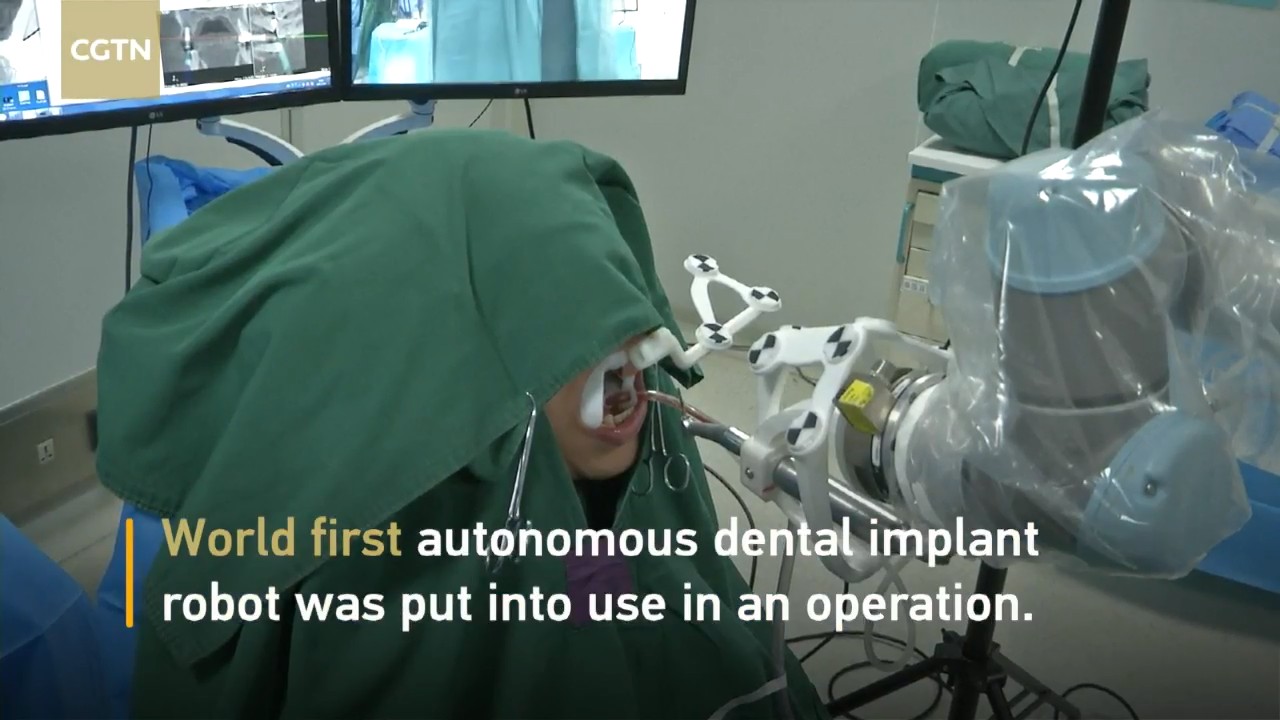
On September 16, 2017, for the first time in the world, a robot in the Xian city of the Chinese province of Shaanxi performed a dental operation without human intervention, the
South China Morning Post reported . The medical staff was present nearby during the procedure, but did not actively participate in the operation.
In less than an hour, the robot installed a woman two teeth printed on a 3D printer.
The process is fragmentary shown in video (16+).
The video shows that the patient first had a CT scan and made a digital 3D model of all the teeth and jaw, and then applied a special marking system so that the robot could navigate, so to speak, on the ground. Apparently, the experts also set the trajectory of the movements in advance, and then the mechanism simply followed the instructions, deviating from the specified course by no more than 0.2-0.3 mm (this is the declared accuracy).
Reportedly, the robot was developed by specialists from Beihansky University (full name is Beijing University of Aviation and Cosmonautics) and the Dental Hospital of the Fourth Military Medical University.
It would seem that it is terrible to entrust such a delicate procedure to a robot - what if it mixes something up, suddenly something breaks. But actually the opposite is true: Dr. Zhao Yimin from the Dental Hospital of the Fourth Military Medical University said in a commentary to the newspaper that the robot allows us to avoid human errors while performing dental operations. Theoretically, it should work more cleanly, accurately and accurately.
In this version, the robot simply followed a set of pre-programmed commands, performing the specified procedures in order and under the supervision of specialists. However, there was still a certain degree of autonomy: the robot adjusted to the patient's movements - and made an adjustment to the tool's trajectory. As shown in the video, the woman thoughtfully closed her eyes.
New development is not created for the sake of world records or to again say that China in some way became the first. No, he solves a practical pressing problem. The fact is that in China there is now a shortage of qualified dentists. China is not alone in this trouble. Experts warn that in the near future neighboring Hong Kong and Singapore may face a similar problem. Even very high salaries for dentists do not allow attracting enough labor to China. For reference, the average annual salary of a dentist in China is
$ 45,992.89 per year , that is, $ 3833 per month. According to the “mac-index”, Chinese dentists are in sixth place in the world. However, if the country does not have an academic system of high-quality training of specialists in large numbers, then no salary will help. Worse, patients are at risk of poor-quality medical care if, in the conditions of a shortage of staff, insufficiently qualified doctors are employed. So here is one hope for robots.
According to the
South China Morning Post , in China, about 400 million people need implantation of dental prostheses. One can imagine how many specialists are required to serve such an army of patients.
Experts say that robotic operations, albeit with minimal human involvement, allow for higher accuracy of actions. With the help of robots, it is possible to perform complex surgical interventions that would otherwise be unavailable.
In Western countries, the use of robots in surgical operations has long been resorted to. According to a retrospective study of 14 years of similar practice in the USA,
144 patient deaths are associated with the use of machines. But this does not mean that surgical operations using robots are less safe than without their participation, because a certain percentage of mortality is always present. In this case, the number of unsuccessful outcomes represents only a small part of all operations that robots have performed.
Interestingly, according to the calculation of the Oxford University in 2013, orthodontists and prosthetists are included in the
list of the safest professions that automation is least likely to touch. As you can see, reality refutes the calculations of scientists.
In March 2017, the US Food and Drug Administration
approved the use of a Neocis robotic system called Yomi to assist dentists in dental implants.